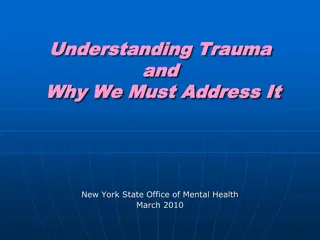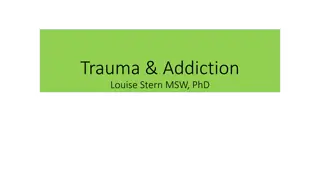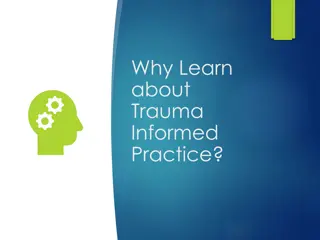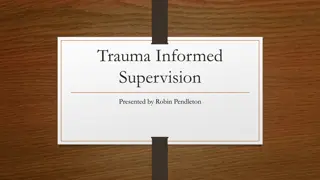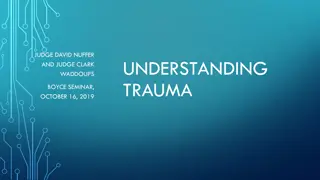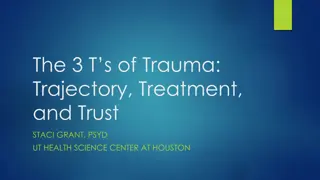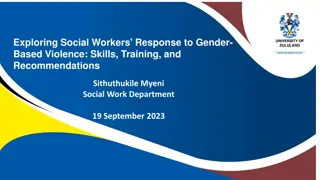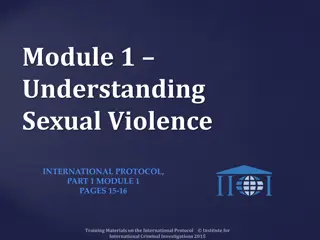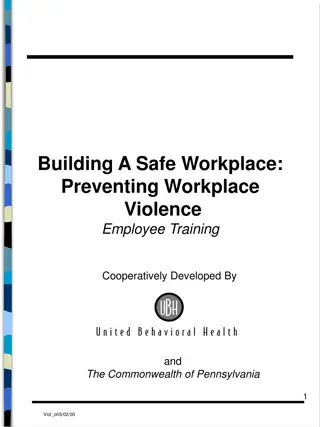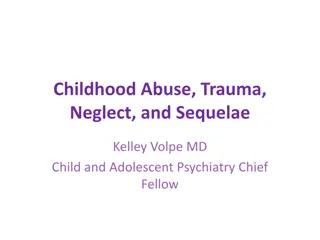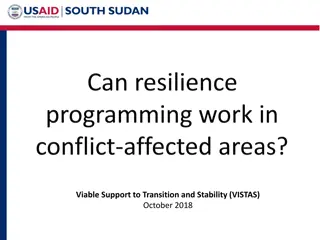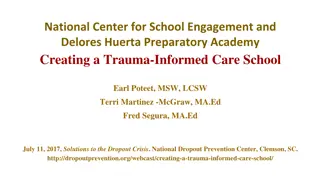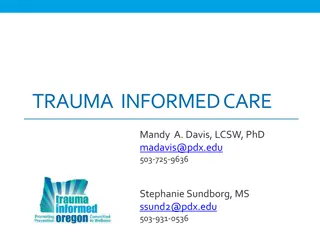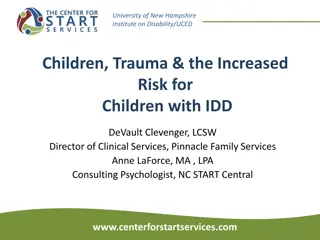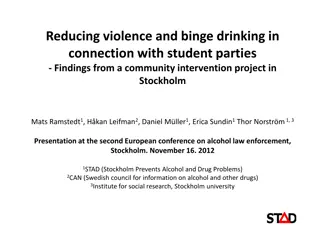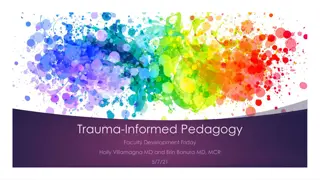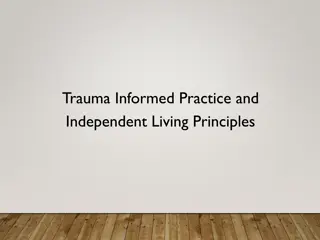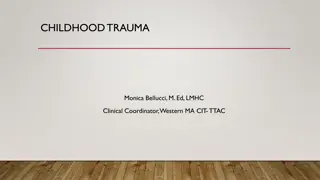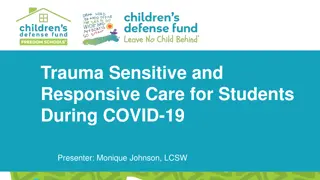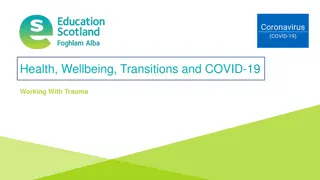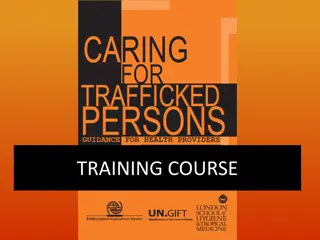Understanding the Relationship Between Trauma and Resilience in Response to Violence
Impact of Trauma on Development: Traumatic experiences in childhood can have long-lasting effects on brain development, emotional regulation, and social relationships. Additionally, lessons learned about resilience highlight the complex nature of this trait and the importance of external factors in fostering resilience in children. The interplay between trauma and resilience is crucial in shaping responses to violence and promoting healthy outcomes in youth.
Download Presentation

Please find below an Image/Link to download the presentation.
The content on the website is provided AS IS for your information and personal use only. It may not be sold, licensed, or shared on other websites without obtaining consent from the author. Download presentation by click this link. If you encounter any issues during the download, it is possible that the publisher has removed the file from their server.
E N D
Presentation Transcript
The Relationship between Trauma & Resilience USING DATA TO DRIVE SYSTEM REPONSES TO VIOLENCE Bryan Samuels, Commissioner Administration on Children, Youth and Families
COMMUNITY VIOLENCE/STUDENT SHOOTING AND CHILD WELFARE CASES November 1, 2011 Forum on Youth Violence Prevention 2
Impact of Trauma on Development The developmental stage of the child at the onset of traumatic exposure will influence the type and severity of the consequences.1 IMPACTS: How children understand their experiences Ongoing exposure to trauma can lead to chronically high or low levels of cortisol in the brain, associated with significant health problems and neurological damage later in life.2 Whether developmental tasks are being achieved on schedule The ability to develop secure attachments and form healthy relationships can be compromised by the impact of experiences of violence and trauma.3 The identification of emotions and the capacity to express and modulate them safely can become impaired in children and youth who have experienced complex trauma. How children cope with adverse experiences Children who are unable to consistently regulate internal experience may turn to alternative strategies, including dissociative coping (e.g., chronic numbing of emotional experience), avoidance of affectively laden situations, including positive experiences, and/or use of behavioral strategies (e.g., substance use). Those children who are unable to find consistent strategies to assist them in modulation of emotion may present as emotionally labile, demonstrating extreme responses to minor stressors, with rapid escalation and difficulty self-soothing. 4 The availability of supports to buffer against negative outcomes 1. Frederico, MM; Jackson, AL; & Black, CM. (2005). Reflections on Complexity: The 2004 Summary Evaluation of Take Two. Bundoora, Victoria: School of Social Work and Social Policy, La Trobe University. 2. Perry BD; Pollard RA; Blakely TL; Baker WL; & Vigilante D. (1995). Childhood trauma, the neurobiology of adaptation and use dependent development of the brain: How states become traits. Infant Mental Health Journal. 16:271 291. 3. Cook, A, Blaustein; M, Spinazzola, J; & van der Kolk, B. (Eds.). (2003). Complex Trauma in Children and Adolescents: White Paper from the National Child Traumatic Stress Network Complex Trauma Task Force. Substance Abuse and Mental Health Services Administration (SAMHSA, USDHHS). 4. Ibid. November 1, 2011 Forum on Youth Violence Prevention 3
Lessons Learned about Resilience 1. Resilience is not a single trait or process many attributes and processes are involved. 2. There are multiple pathways to resilience. 3. It is easy to make the mistake of blaming the victim when resilience does not occur, if one assumes that resilience arises only from internal capacities. 4. The evidence strongly implicates the roles of transactional processes and adaptive capacity arising external to the organism in resilience. 5. There are no magic bullets for producing resilience. 6. There are no invulnerable children. 7. There are levels of risk and adversity so overwhelming that resilience does not occur and recovery is extraordinarily rare or impossible. Masten, AS & Obradovi , J. (2006). Competence and resilience in development. Resilience in Children. 1094:13. November 1, 2011 Forum on Youth Violence Prevention 4
Dimensions through which experiences of trauma and violence impact children in the short- and long-terms Protective mechanisms can serve in multiple functions; what is important is how they contribute to healing and recovery Promoting Well-Being Protective Mechanisms Understanding Experiences: Dimensions through which experiences of trauma and violence impact children in the short- and long-terms Protective Mechanisms: Protective mechanisms can serve in multiple functions; what is important is how they contribute to healing and recovery Healing & Recovery: Locus of interventions to promote social and emotional functioning to facilitate healing and recovery Understanding Experiences Developmental Tasks HEALING Social and Emotional Well-Being & RECOVERY Coping Strategies Environmental Buffers Locus of interventions to promote social and emotional functioning to facilitate healing and recovery Protective Mechanisms November 1, 2011 Forum on Youth Violence Prevention 5
Promoting Resilience Domains/Constructs Indicators Age-appropriate autonomy, emotional self- regulation, persistence, constructive time use Self-management Planfulness, resourcefulness, positive risk-taking, realistic goal-setting, motivation Agency Believing one s life is meaningfully connected to a larger picture Sense of purpose Confidence Positive identity and self-worth Communication, cooperation, conflict-resolution skills, trust, intimacy Social Intelligence Adapted from: Lippman, LH; Moore, KA & McIntosh, H. (2011). Positive indicators of child well-being: A conceptual framework, measures, and methodological issues. Applied Research in Quality of Life. Accessed on August 16, 2011. http://www.springerlink.com.proxy.uchicago.edu/content/tr32721263478297/. November 1, 2011 Forum on Youth Violence Prevention 6
Promoting Resilience (Contd.) Domains/Constructs Indicators Environmental awareness and behavior Knowledge, positive behaviors Skills and knowledge to avoid drug and alcohol use and risky sex Risk management skills Critical thinking Evaluation/analytical/problem-solving skills Knowledge of essential life skills Financial management, decision-making skills, home maintenance, etc. Positive relationships with peers, siblings, family, etc. Warmth, closeness, communication, support, positive advice Adapted from: Lippman, LH; Moore, KA & McIntosh, H. (2011). Positive indicators of child well-being: A conceptual framework, measures, and methodological issues. Applied Research in Quality of Life. Accessed on August 16, 2011. http://www.springerlink.com.proxy.uchicago.edu/content/tr32721263478297/. November 1, 2011 Forum on Youth Violence Prevention 7


